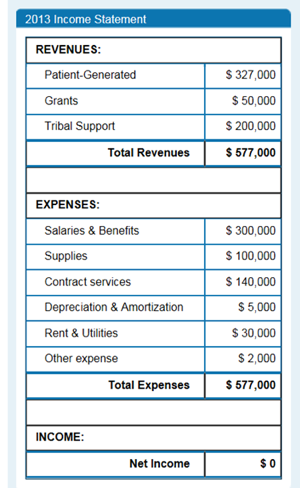
Financial Planning Steps

To plan for financial stability, your LTSS program should:
- Create a budget showing payers and comparing income and expenses—or estimating them, if your program is new
- Set performance targets to help reach your program's financial goals
- Calculate how many patients your LTSS program needs to serve to make enough money to cover operating costs
Step 1: Create a Budget
Determine the payers
LTSS programs often have multiple funding sources. Visuals, like this pie chart, make it easy to see how much each payer contributes to your program.

In this example, patient-generated revenue from Medicaid, Medicare, self-pay, and private insurance makes up 57% of the pie. Tribal support is the next biggest slice, then grant funding.
Learn the pros and cons of different revenue sources at Who Pays for LTSS?
Create an income statement
Example LTSS income statement:

Income statements compare revenues and expenses over a certain period of time to figure out whether you lost resources, gained income, or broke even during that time.
You'll need the following information to develop an annual income statement.
Total annual revenue, including:
- Revenue from patients (from Medicaid, Medicare, private insurance, and self-pay)
- Any grant funds received
- Any funding support provided by the tribe
Total annual expenses, including:
- Staff salaries and benefits
- Amount spent on supplies and equipment
- Amount spent on the facility, such as rent and utilities
*Source: Adapted from C. Harrison and W.P. Harrison, 2013, Introduction to Health Care Finance and Accounting, Clifton Park, NY: Delmar
Step 2: Set performance targets
Once you have a current budget and a clear picture of your payer mix, you can set performance targets, which are financial goals you want your LTSS program to reach by a particular date. Some example financial performance targets include:
- Increase total revenue to $750,000 within the next calendar year
- Generate 70% of total revenue from patient-generated sources by the end of the calendar year
- Increase Medicaid revenue to 60% of total patient-generated revenues within the next calendar year
Step 3: Do a break-even analysis
In the sample income statement above, the program generates $ 0 net income: does not lose money, and it does not make a profit. This is known as breaking even.

Your LTSS program probably will not break even at first, but doing a break-even analysis is still important. It shows you how many patients your program needs or how many billable services you need to provide to make enough money to balance program costs.
Tip: If your program does not serve enough patients to break even, consider employing staff who split their time between the LTSS program and other tribal programs.
Tip: If your program is facility-based and the beds or rooms are under-utilized, consider adding other services, such as transitional care, to increase occupancy.
Cost considerations
Keep in mind that different types of LTSS programs have different operating costs.
Home- and community-based services
- Can often be provided at a much lower cost than facility-based care
- Fewer patients and services are needed to cover operating costs and break even with your budget
Facility-based care
- Often has a much higher cost because facilities must maintain a building and provide 24-hour skilled nursing care
- A facility needs more patients (and more revenue) to break even
